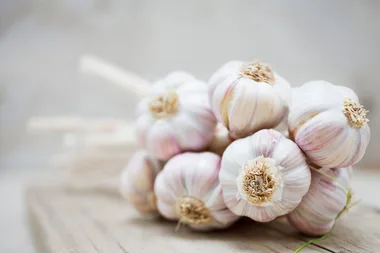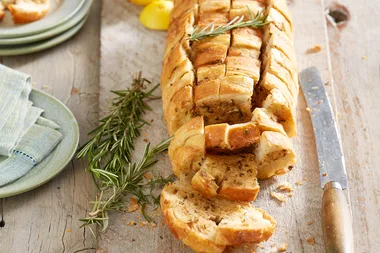When creating your veggie patch, the first ingredients that should spring to mind are foods you can use in your everyday cooking. Garlic definitely falls into this category, with the pungent bulb a versatile staple for everything from roasts and marinades to stir-fries, pasta dishes and garlic bread.
In fact, 39% of Australian households buy fresh garlic every year according to data from the Australian Horticulture Statistics Handbook, making it even more popular than chilli, ginger and even fresh herbs!
While it’s easy to pick up a bulb at the supermarket, there’s nothing quite like harvesting garlic and other vegetables from your garden. So, we’ve compiled this guide on growing garlic in Australia, including planting conditions, how to grow garlic from a clove and when to harvest it.
Fast facts: Growing garlic
- Name: Garlic (Allium sativum).
- Climate: Garlic grows best in temperate climates with mild winters and warm summers. It requires a period of cold weather (winter chill) to initiate bulb formation but prefers moderate temperatures during the growing season.
- Soil: Fertile and free-draining soil.
- Position: Full sun.
- Feeding: Adding a quality controlled-release fertiliser at planting time can be beneficial.
- Watering: Garlic doesn’t require a lot of water, except during dry periods, but it ensures that the soil drains well.
- When to plant: Autumn planting
- Harvesting: Summer (7-8 months after planting)

When and where to plant garlic
The soil and temperature are crucial when growing your own garlic.
The best time to plant garlic on the Australian calendar is in March or early April in warmer climates. In cooler parts of Australia, spring is preferable.
In your garden, look for a spot exposed to the sun. The soil should also be well-drained.
Soil factors
Select an area where garlic or its relatives (e.g. onions, shallots, leeks or chives) have not been planted the previous year in full sun with fertile and free-draining soil.
You can improve heavy or sandy soil by turning it and working through manure or compost.
The soil should have a pH of between 5.5 and 7.
How to grow garlic from a clove
- Prepare the planting site: Choose a sunny location in your garden with well-draining soil. Avoid areas prone to waterlogging, as excessive moisture can cause bulb rot. Prepare the soil by loosening it to a depth of about 20 cm and removing any weeds.
- Fertilise: Apply a slow-release fertiliser at planting and again three months later. In spring, apply a nitrogen-based fertiliser to fatten out the bulbs.
- Break apart the bulbs: Separate the cloves and plant the largest ones into moist soil about 2-3 cm deep and 15 cm apart. Push them in, pointy end up, until they sit just below ground level.
- Water: Keep the soil moist but not waterlogged throughout the growing season, especially during dry periods.
- Mulch: Apply a layer of mulch, such as straw or shredded leaves, to help retain moisture and suppress weed growth.
Can you grow garlic from store-bought cloves?
Some supermarkets spray their garlic bulbs with a sprouting inhibitor, which means they won’t grow if planted in your garden. While you could still try your luck with garlic cloves from a supermarket, it’s typically better to buy your bulbs from nurseries or even farmer’s markets. This way, you can choose the variety of garlic you want and be sure it will grow.
Can you plant garlic gloves that have sprouted?
You can plant garlic cloves that have sprouted. Sprouted garlic cloves are often preferred for planting because the sprouting indicates that the clove is viable and ready to grow.

Garlic varieties
Garlic can broadly be categorised as either a softneck or hardneck variety. A softneck garlic doesn’t typically produce a scape (the green part that grows from the bulb) or umbel (flowers on that scape), while hardneck varieties do.
According to the Australian Horticulture Statistics Handbook, there are five main varieties grown in Australia:
1. Turban garlic
This is the most common type of hardneck garlic grown in Australia and accounted for 60% of production in the 2022/23 year. Its flavour profile is probably familiar to you, with a hot quality when it’s raw and more mild flavour when you use it in cooking.
2. Artichoke garlic
Identified by having fewer yet larger cloves, artichoke garlic can be recognised by sometimes having purple spots on its skin. The flavour is more mild than some other garlic varieties and it accounted for 20% of production in the 2022/23 year.
3. Subtropical garlic
This is a newer group of Australian cultivars of garlic, accounting for 15% of fresh production. According to Australian Garlic, they grow well in regions with shorter days, relatively cold, dry winters and can have a “rich, sweet, spicy flavour”.
4. Creole garlic
Creole garlic is a group of hardneck varieties that have a hot, spicy and rich flavour. They have a smaller bulbs with white outer skin, sometimes with purple tones, and grow best in hot, dry climates.
5. Marbled purple stripe garlic
As the name suggests, this hardneck variety is identified by purple stripes and colouring. It grows best in cooler climates and has large cloves with some heat to the flavouring.
Other types of garlic you may find at nurseries
Silverskin garlic
This variety has a strong flavour and is perfect for growing garlic with a long shelf-life.
Rocambole
Rich in taste, rocambole peels effortlessly. Doesn’t keep as long as other varieties, just six months.
Porcelain
Similar in flavour to rocambole, porcelain garlic only has several cloves covered by a white casing. Porcelain garlic tends to keep for around eight months.
Caring for garlic in your garden
Your home-grown garlic must be well cared for during the growing process. Choose a high-nitrogen fertiliser to help feed the plants. As the weather warms up after winter, garlic can form flower stalks. Ensure that you remove the stalks to maximise the growth of the actual garlic bulb.

How do you know when garlic is ready to harvest?
Typically, Australian homegrown garlic is ready about seven to eight months after being planted. Signs garlic is ready to be harvested include green leaves turning brown, and flower stems beginning to soften.
If the garlic is buried close to the surface, you can pull it out by the leaves. Otherwise, if it is too deep, use a gardening fork to lift it out carefully.
How to grow garlic with companion plants
Companion planting is a method that allows the plants your growing to support each other. A fundamental part of this method is the idea that different varieties of plants can serve different functions that benefit one another.
Garlic, in particular, can make a good companion plant for other fruit, vegetables and flowers in your garden because is relatively easy to grow, takes up next to no space, and improves the soil quality for the plants around it.
The strong smell of garlic also means it helps deter pests, including:
- Cabbage loopers
- Spider mites
- Codling moths
- Fungus gnats
- Ants
- Snails
So even if growing garlic isn’t your priority, its qualities mean it can be a benefit to other more vulnerable plants in your garden. This includes:
- Strawberries
- Spinach
- Broccoli, cabbage, kale and other cruciferous vegetables
- Tomatoes
- Roses
On the other hand, if growing garlic is your main focus, you could consider planting two or more varieties. That way you can see how each one grows, compare the qualities and then choose your favourite (or favourites).


